Dr. Noel Fallows is the man who literally wrote the book on jousting, Jousting in Medieval and Renaissance Iberia, that is. It is a must read for anyone interested in the historical aspects of jousting. It was such a ground-breaking academic text that it was awarded both the University of Georgia’s Creative Research Medal and the La Corónica International Book Award for 2012.
Dr. Fallows himself was recently honored by being chosen to receive the 2014 Albert Christ-Janer Award for distinguished achievement in the arts and humanities, which recognizes outstanding bodies of work that have gained broad recognition. He is also a Fellow of The Society of Antiquaries of London.
His award-winning book, Jousting in Medieval and Renaissance Iberia, is divided into two major sections. In the first section, Dr. Fallows shares the information he has gathered regarding historical jousting based on his own work in translating several 15th and 16th century manuscripts. The second section shares his English translations alongside the original text of several of the manuscripts. The book also includes an actual size facsimile of the entire manuscript for Lo Cavaller, originally published in 1493. Even if it only included the translation section, Jousting in Medieval and Renaissance Iberia would still be an invaluable resource for those interested in the history of jousting.
Earlier this year, when I asked Dr. Fallows if he would be willing to do a written interview for The Jousting Life, I was not expecting him to agree. When he agreed to the interview, he was probably not expecting the five pages of questions that I sent him. (I did suggest that he only answer the questions that he found interesting.) He surpassed expectation when he provided answers to almost every single question. He is truly a gentleman and a scholar.
Without further ado, the interview:
What led you to research jousting specifically? (I know you've been asked this before, but...)
I originally set out to write a book about the entire corpus of Renaissance Spanish military manuals, and had already done some work on the little-known jousting manuals. I made a research trip to the Kelvingrove Museum in Glasgow in 2004 to conduct research on the military books in the R.L. Scott Collection. At that point I realized that a book about all of the Spanish military manuals was going to be much, much more difficult than I had anticipated.
In Glasgow I met Toby Capwell, who was at that time the Curator of the Scott Collection. In a discussion over lunch I realized that there was probably an entire book to be written about the jousting treatises alone, especially if I could count on Toby’s expertise to help me unravel some of the knottiest issues about the texts, which are very difficult to understand. So that’s how it came about.
In the preface to your book, you state, “I hope that it will also be of use to practicing jousting enthusiasts.”(p. xxiii) When did you realize that many contemporary jousters consider your book the most comprehensive source of information about the historical roots of their sport? How does that make you feel?
It’s great. I knew that jousting was still practiced, but that the serious practitioners had very little to go on insofar as the technicalities were concerned, so I decided to write this book as much for the general, interested reader, as well as the academic community. This was quite a new thing to do in my particular field of expertise.
According to the historical documents that you worked with, what made for a really good joust in medieval and renaissance Iberia?
It would have varied from one joust to another. The jousts of war would have been quite solemn –- this is the case with the Passo honroso, for example. In other cases, such as the most elaborate jousts of peace, the mood would have been decidedly festive. In some cases, judging by the account of Luis Zapata, clowns and jesters would initially work the crowd to get everyone in a festive mood, though Zapata also says that he disapproves of this strategy, as it conflicts with his view of jousting as an aristocratic sport.
For the jousters themselves, the tournament could start out ideally with poetry. The jousters would lampoon each other in short, witty poems known in Spanish as “invenciones” before the jousting actually began –- a kind of festive medieval Roast. These poems also became a popular feature in the fictional jousts described in Spanish chivalry novels. Many of these novels were translated into English in Tudor times, at which point the Tudor jousters who read the novels picked up on the poems and started to include them in their own real-life jousts -– an interesting circularity.
The jousters would often be led into the field by heralds and trumpeters, and then ride a preliminary lap around the field, surveying the crowd at the same time as the spectators could admire the jousters’ panoply. It’s clear that at all jousts the spectators were expected to remain silent while the jousters actually ran the courses, so as not to distract them or the horses.
Then of course the best competitions were the ones where the jousters scored solid hits in each course. If you look at my book, there is a good joust described on pp. 437-9, where they strike each other every time and both men jousted so well that it is difficult for the judges to decide who won. Alternatively there is a really bad joust -- 27 courses, mostly misses -- on pp. 412-14. The festival did not end there, however, as the best jousting tournaments would end with a sumptuous banquet in the evening.
Based on your research, what do you believe the authors of your historical sources saw as the most important quality of a jouster?
Physically, I describe the knights as “callipygian heroes”, which means that they had shapely buttocks, thighs and legs! Since they wore hoses, this was believed to be where a man’s beauty resided and was easily visible. Also technical virtuosity with the lance, and what the Spanish authors call “mesura”, which basically means “restraint”, as well as other qualities like elegance, wit and general charisma.
What do you believe are the differences between the way the historical knights thought about their participation in tournaments and the way modern jousters view their sport?
Well, for this you will have to get input from the modern jousters. I am guessing that most modern jousters also have a day job that has little or nothing to do with the sport. For the historical knights this was an integral part of their daily lives.
While doing the research for this book, what things surprised you most about the actual accounts of jousting?
How much care and sheer skill went into delivering the lance thrusts, and all of the precautions that were taken to avoid fatal injuries but without diminishing the excitement. I was also struck by the fact that the experts disagree about how best to handle certain issues, such as how to keep the eyes open at the moment of impact: one says you should focus on the tip of your own lance; another says focus on the tip of the opponent’s lance; and still another says that if you keep your mouth open, your eyes should stay open as well.
One of my other interests was to see how the authors were struggling to define the technical terminology of the sport – this is a fascinating insight into the development of technical writing as we have come to know it today, though with no unified technical vocabulary it makes the accounts incredibly difficult to understand.
Was there anything you had to leave out of your book that you wish you could have left in? What was it?
Not really – it’s already a huge book. I have found a lot more stuff since the book was published that I wish I had found earlier on, but that’s the nature of this type of research. Maybe a companion volume will one day be in order!
Have you ever been to a contemporary competitive jousting tournament?
I saw Toby Capwell joust at Hampton Court last year and will be attending the Schaffhausen joust for a few days this summer. I am very interested in seeing how the armour actually works at these historically accurate events.
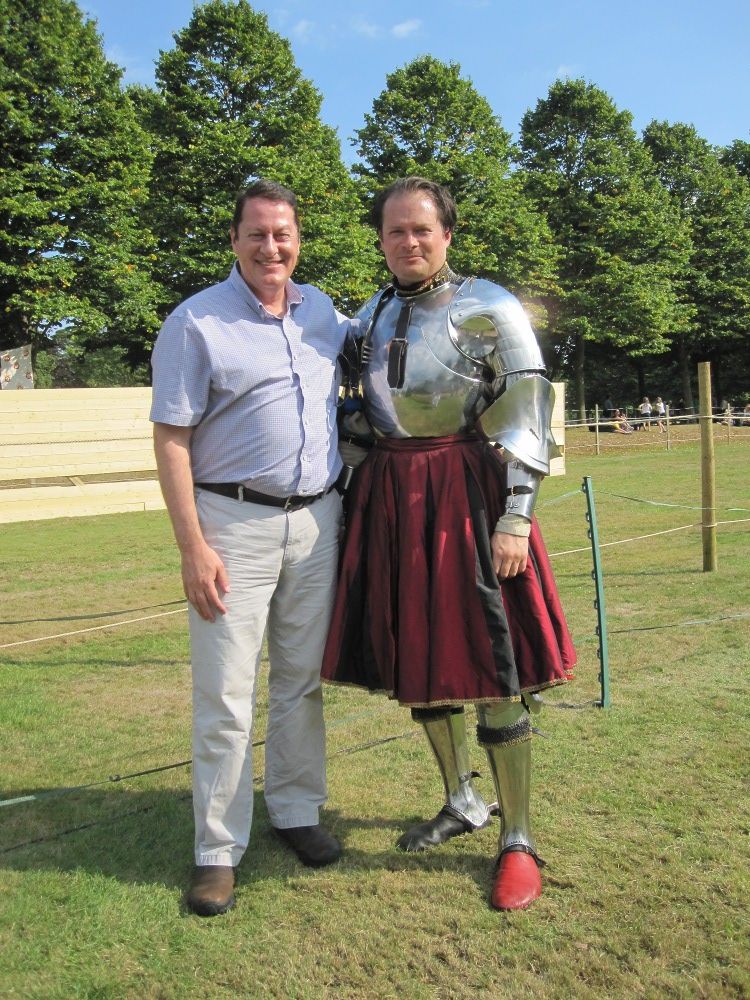
Dr. Noel Fallows and Dr. Tobias "Toby" Capwell at Hampton Court in August 2013. Noel notes that "Toby’s shoes and skirt are red and black, the colours of the University of Georgia!!"
(photo from Noel Fallows)
Which of the historic figures that you researched for your book did you find most interesting? What made him/her so interesting to you?
One of the jousters is Don Luis Zapata. The complexity of his personality and his life was fascinating. He says that he actually slept in his greaves so as to keep his legs in good shape, and he also seems to have been a pacifist at the same time as he was an expert jouster.
You describe being allowed to handle some extremely rare fifteenth century pieces at the Royal Armouries and state that “Handling such items can best be described as akin to traveling in time, and is one of the great luxuries of being a medievalist”(p. xxvi) Please describe your favorite experience of being allowed to handle a historic artifact.
I enjoyed handling the 1435 armet by Benedetto da Molteno of Milan in the Royal Armouries. One minute I was looking at it through the display case; the next minute I was allowed to handle it, under the supervision of the curator – great stuff. I also handled some great war hammers at the Met Museum in NYC.
“I shall contend in this book that chivalry must be seen in order to be properly understood” (p. 27) How do you think that historical jousting tournaments such as The Grand Tournament of Sankt Wendel help to understand jousting better than by just researching the subject in historical texts?
I think that these are a must. When the armour is static on a mannequin in a museum, you can get some sense of what it is, but only as an artefact or relic. But the best way to understand how it actually worked is to try to reconstruct period armours as accurately as possible and then put them through their paces following the instructions in the historical manuals. By the same token, some of the descriptions in the manuals only really become clear when the armour is worn and tested.
The Grand Tournament of Sankt Wendel(video by Ben van Koert/Kaos Historical Media)
In your discussion of the rapid evolution of jousting armour, you mention that tournaments provided a venue for an international exchange of ideas.
(A) Besides encouraging changes in armour styles, what effects do you think this contact between knights and armourers of different nations had?
One of the new details that I have just discovered that did not make it in time for the book, is a Spanish treatise in which the author is telling King Felipe II that Spain has to have a better contingency of master armourers so as to compete better with the Italians and Germans, so perhaps the international scene promoted a healthy spirit of competitiveness as well as collaboration.
(B) Although international communication is much easier in this day and age, do you think that international sports still have a part to play in encouraging communication between those of different nations?
Certainly.
You describe the sad case of Fernando de Castrionte, Marquis of Civita Sant Angelo, who was killed because he was unaware of, or failed to heed, Quijada de Reayo's statement about reinforcing his reins with chains. (In the battle of Pavia, 1525, the Marquis had his reins cut and lost control of his horse. The horse bolted straight into a platoon of enemy troops who promptly killed the Marquis.) “Proof enough that a strong theoretical background was an asset...”(p. 253) What theoretical knowledge of historical jousting do you think would be most useful to contemporary jousters?
The message I get from the treatises is that you will do the best job and avoid injury if the armour is bespoke and a perfect fit, and the lance-rest must be well sited. When Asbert Claramunt is accidentally killed in one of the jousts of the Passo honroso, his death is attributed to the fact that he had borrowed someone else’s armour and it did not fit properly.
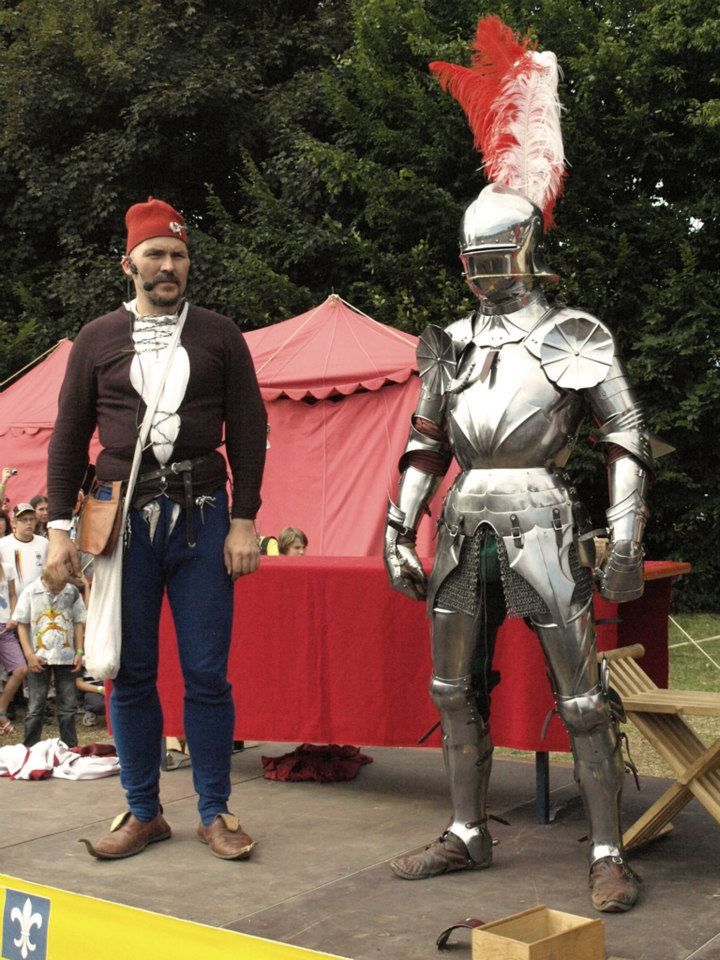
Andrej Pfeiffer Perkuhn(left) and Andreas Wenzel(right) demonstrate how a properly fitted suit of armour is donned and worn during the Grand Tournament of Sankt Wendel. If you look closely, you can see the lance rest(aka arret) on the right side(his right) of Andreas' breastplate. In this picture, it is folded in to be out of the way when not in use.(photo by Bei Litschkovicz)
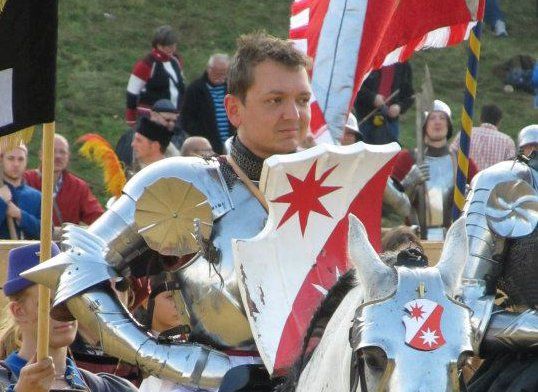
In this picture of Andreas Wenzel, you can see the lance rest(arret) opened out to allow the butt of the lance to rest upon it.(photo by FAMALEONIS)
This interview will be continued in:
"An Interview with Dr. Noel Fallows, Author of Jousting in Medieval and Renaissance Iberia: Part Two"
and
"An Interview with Dr. Noel Fallows, Author of Jousting in Medieval and Renaissance Iberia: Part Three"Related articles:
Video: Dr. Noel Fallows Talks About Chivalry and Jousting
Historical Jousting Tournament at Nyborg Slot in Denmark
There are also numerous articles about The Grand Tournament of Sankt Wendel


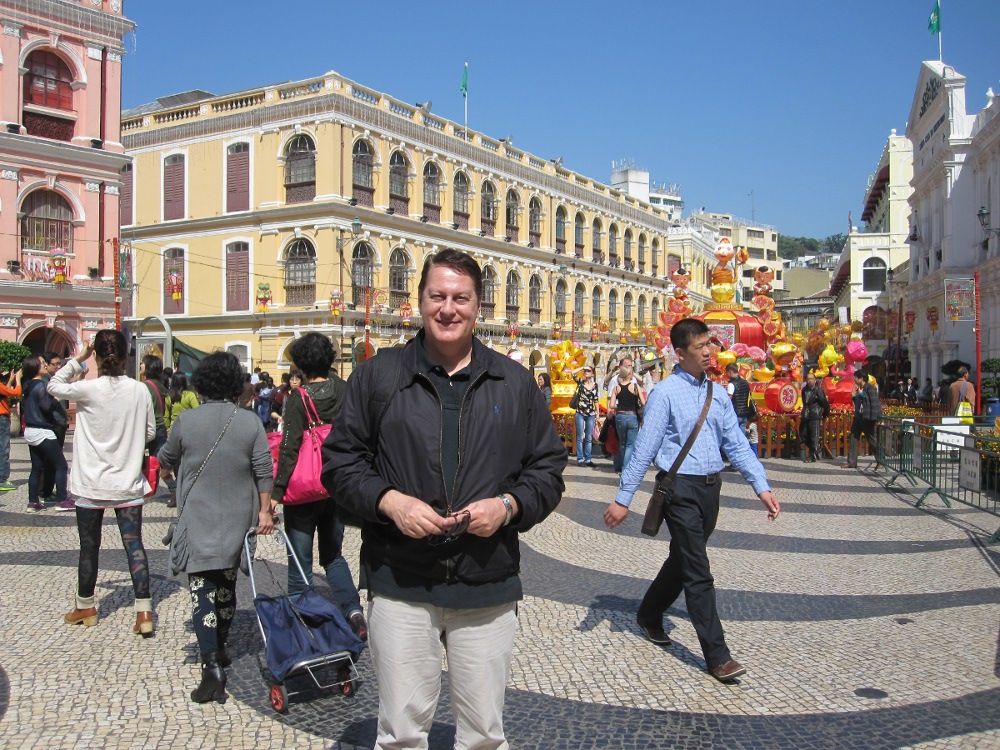
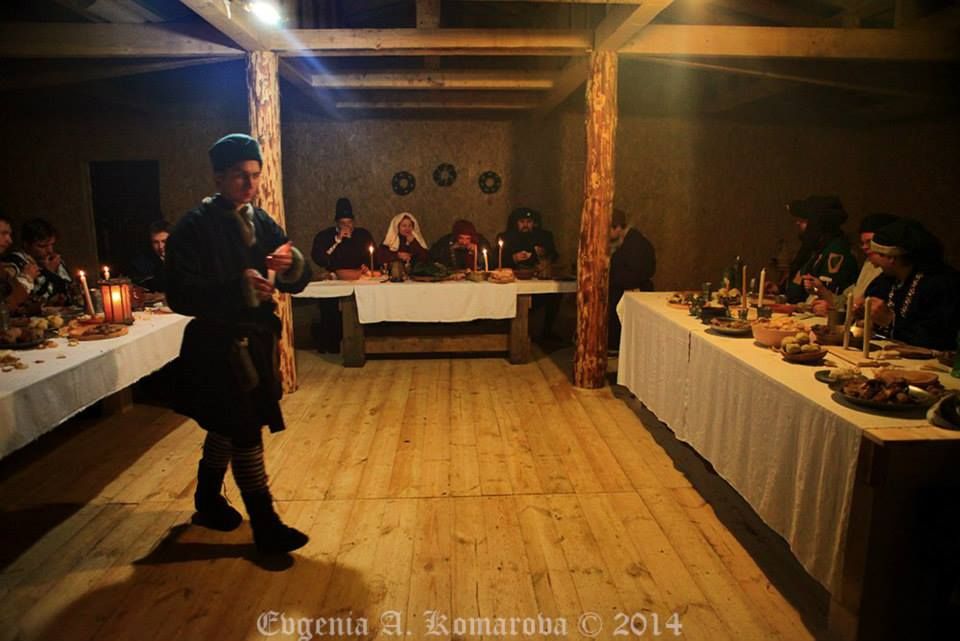
No comments:
Post a Comment